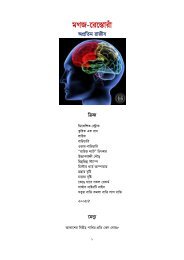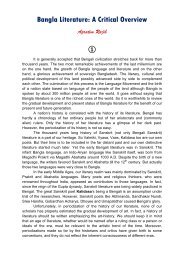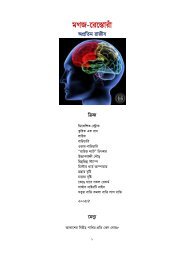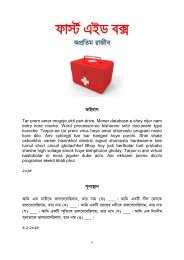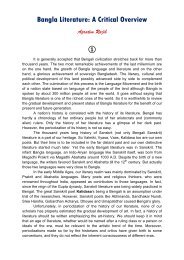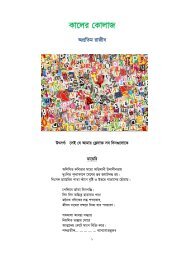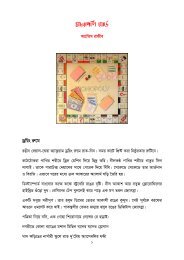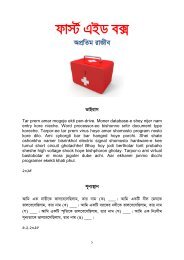Literature-Critique
You also want an ePaper? Increase the reach of your titles
YUMPU automatically turns print PDFs into web optimized ePapers that Google loves.
13<br />
were two late representatives of this epic tradition. But all those ‘epic poets’, in merit,<br />
were far behind Michael.<br />
Krishnachandra Mazumder (1837-1907) wrote Sadbhab Shatak (1861)<br />
following Persian Rubaiyat. Dwijendranath Tagore (1840-1926), the eldest brother of<br />
Rabindranath, composed a romance poem in blank verse entitled Sapnaprayan<br />
(1875). Jagatbandhu Bhadra’s (1841-1906) Chucchundaribadh (1868) is a parody of<br />
Meghnadbadh; he satirized Michael’s epic style in this poem. Another satirist named<br />
Indranath Bandyopadhyay (1849-1911) wrote the mock-epic Bharat-Uddhar (1878).<br />
Biharilal Chakraborty (1835-’94), Surendranath Mazumder (1838-’78),<br />
Gobindachandra Das (1855-1918), Devendranath Sen (1858-1920) and<br />
Akshaykumar Baral (1860-1919) introduced lyrical poems in Bangla. Biharilal is<br />
called the ‘Morning Bird’ of Bangla lyrical poem. He became ideal to many young<br />
poets including Tagore. Saradamangal (1878) is his masterpiece.<br />
Even before Bankim, Tekchand Thakur wrote the first ever Bangla novel –<br />
Alaler Gharer Dulal (1858). But Hutome Pencha’s (pen-name of Kaliprasanna<br />
Simha) Naksha (1861-’62) is widely regarded as the best social document of the 19 th<br />
century.<br />
Mir Mosharraf Hossain (1847-1912) and Rameshchandra Datta (1848-1909)<br />
wrote historical novels following the model of Bankim. Maharastra Jibanprabhat<br />
(1878) and Rajput Jibansandha (1879) are two famous historical novels by<br />
Rameshchandra. Mosharraf narrated the story of assassination of Imam Hossain at<br />
the battle-field of Karbala in his prose-epic Bishad Shindhu (1885-’91). Taraknath<br />
Gangopadhyay (1843-’91) wrote a family-story entitled Swarnalata (1874) and<br />
Trailokyanath Mukhopadhyay (1847-1919) wrote humorous works.<br />
Bangla drama got its birth in this period. It will not be wrong to say that<br />
Shakespeare was the role model of the playwrights. However, they never achieved<br />
the great writer’s height. Michael composed several good tragedies and comedies.<br />
Besides, he also wrote a farce entitled Akei Ki Boley Sabhyata? (1860). And<br />
Dinabandhu Mitra (1830-’73) wrote a famous social play titled Nildarpan (1860) and<br />
a class farce entitled Sadhabar Ekadashi (1866). Nildarpan was a protest against the<br />
atrocities of the British tyrants of the 19 th century. Girishchandra Ghosh (1844-1912)<br />
wrote mythic, historical and social plays being influenced by Bankim’s nationalistic<br />
ideologies. His excelled not as a playwright but as an actor and director. Amritlal<br />
Basu (1853-1929) wrote satirical comedies.<br />
Sanjibchandra Chattopadhyay (1834-’89), elder brother of Bankim, wrote<br />
Palamou (1880-’82) – the first ever travelogue in Bangla.<br />
This time’s essay literature was centred on theological issues. Bankim,<br />
Devendranath Tagore (1817-1905), Rajendralal Mitra (1822-’91), Rajnarayan Basu<br />
(1826-’99), Bhudev Mukhopadhyay (1827-’94), Keshavchandra Sen (1838-’84) and<br />
Dwijendranath Tagore were the renowned essayists of the age. They mainly wrote<br />
on religion and philosophy. Devendranath preached philosophies of the<br />
Upanishadas. Bhudev wrote on social and family values.




